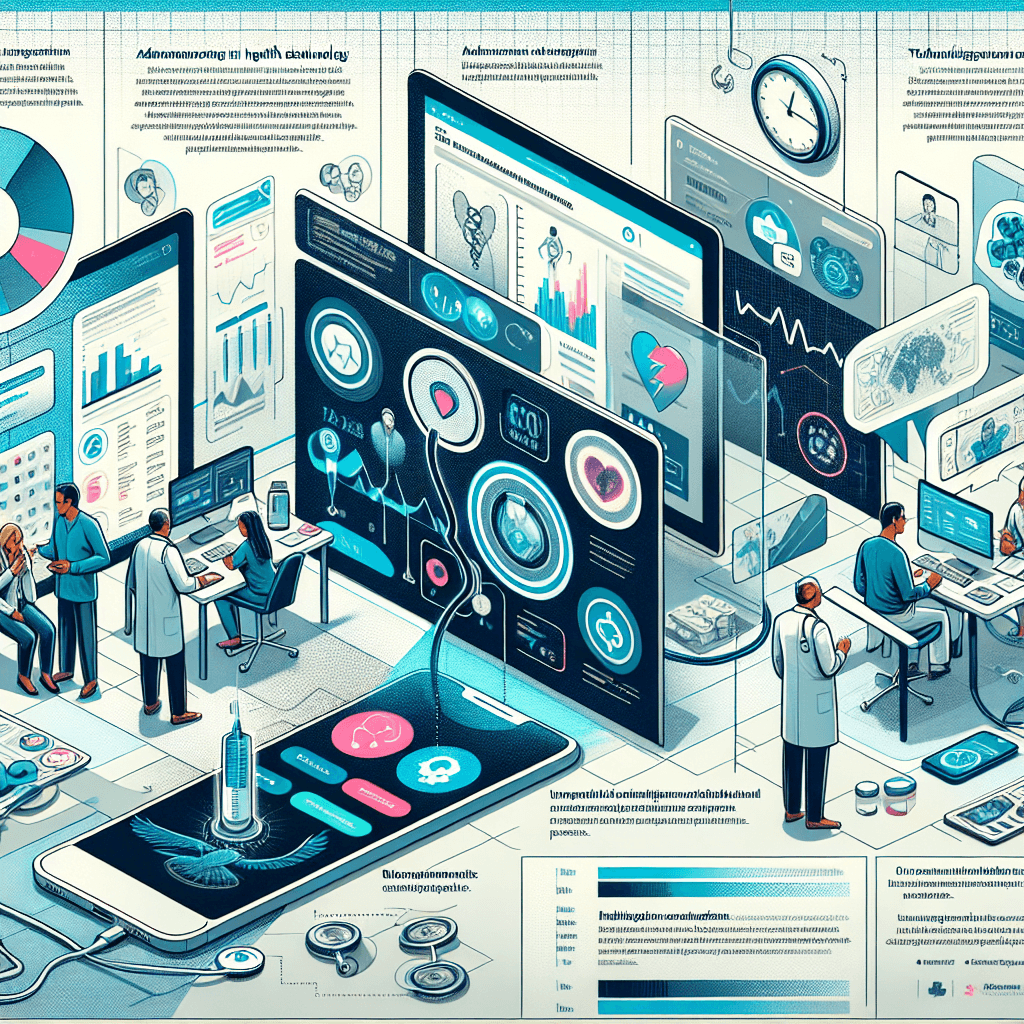In today’s rapidly evolving healthcare landscape, the integration of technology has revolutionized not only the way we receive medical care but also how insurance coverage is shaped. With the emergence of innovative health tech solutions, such as wearable devices, telemedicine, and digital health platforms, there is a growing need to comprehend the profound impact these advancements have on insurance policies. By better understanding the connection between health tech and insurance coverage, individuals and insurers can effectively navigate this transformative era, ensuring comprehensive and inclusive healthcare for all.

Table of Contents
1. Overview of Health Tech
1.1 Definition of Health Tech
Health Tech refers to the integration of technology into healthcare services and systems to improve the delivery, accessibility, and effectiveness of healthcare. It encompasses a wide range of technologies, including digital health platforms, wearable devices, artificial intelligence, telemedicine, and health data analytics. Health Tech aims to empower individuals to take control of their health, enhance healthcare professionals’ ability to provide quality care, and optimize healthcare processes and outcomes.
1.2 Examples of Health Tech Innovations
There are numerous examples of Health Tech innovations that have revolutionized healthcare and insurance industries. One such example is wearable devices, such as fitness trackers and smartwatches, that collect and monitor real-time health data like heart rate, sleep patterns, and physical activity. Another example is telemedicine, which allows patients to consult with healthcare professionals remotely through video conferencing and phone calls, eliminating the need for in-person visits. Additionally, artificial intelligence and machine learning algorithms are being used to analyze vast amounts of health data to identify patterns, predict disease progression, and personalize treatment plans.
1.3 Benefits of Health Tech
The integration of Health Tech into insurance coverage offers several benefits for both insurers and policyholders. For insurers, Health Tech enables more accurate risk assessment based on real-time health data, leading to more personalized coverage plans and improved underwriting processes. It also allows insurers to proactively identify and mitigate risks, reducing claims costs and improving profitability. For policyholders, Health Tech provides greater control over their health by promoting preventive care, increasing access to healthcare services, and facilitating quicker and more convenient claims processes. Health Tech also has the potential to lower insurance premiums by incentivizing healthier lifestyles and assisting in early disease detection.
2. Current Insurance Coverage Landscape
2.1 Traditional Insurance Models
Traditionally, insurance coverage has been based on standardized risk factors, such as age, gender, and medical history. However, this approach often fails to capture the full picture of an individual’s health and lifestyle, leading to generalized coverage plans that may not align with the specific needs of policyholders. This lack of personalization can result in both overcoverage and undercoverage, leading to inefficiencies and dissatisfaction among policyholders.
2.2 Coverage Limitations
Even with traditional insurance models, coverage limitations exist that may prevent individuals from accessing necessary healthcare services. These limitations can include high deductibles, limited coverage for certain treatments or medications, and exclusions for pre-existing conditions. Such limitations can create barriers to care, particularly for individuals with chronic illnesses or those in low-income brackets, making it challenging for them to afford essential healthcare services.
2.3 Challenges in Insurance Industry
The insurance industry faces several challenges, including rising healthcare costs, increasing prevalence of chronic diseases, and evolving customer expectations. Insurance companies must adapt to these challenges while still maintaining profitability and providing quality coverage to policyholders. Additionally, the industry must navigate complex regulatory environments, ensure data privacy and security, and overcome resistance to change to fully leverage the potential of Health Tech.
3. Integration of Health Tech with Insurance
3.1 Use of Health Tech Data for Risk Assessment
One of the key ways Health Tech benefits insurance coverage is through the utilization of health data for more precise risk assessment. By integrating wearable devices and digital health platforms, insurers can gather real-time data on policyholders’ health behaviors and track their adherence to recommended treatments and preventive measures. This data provides valuable insights into individuals’ health conditions, allowing insurers to offer more personalized coverage plans and adjust premiums based on actual health outcomes.
3.2 Personalized Insurance Plans
Health Tech enables insurers to offer personalized insurance plans tailored to the specific needs of policyholders. By leveraging health data collected from wearable devices and health monitoring apps, insurers can identify policyholders’ health risks, develop targeted interventions, and reward healthy behaviors. This personalization helps ensure that policyholders receive coverage that aligns with their individual health goals and encourages them to make healthier lifestyle choices.
3.3 Telematics and Wearable Devices in Auto Insurance
Health Tech is not limited to individual health coverage but can also be integrated into other insurance sectors. In auto insurance, for example, telematics devices and wearable devices can monitor drivers’ behaviors such as speed, braking patterns, and adherence to road safety regulations. This data can be used to assess accident risk accurately, incentivize safer driving habits, and offer personalized coverage plans based on individual driving performance.
3.4 Telemedicine Coverage
Telemedicine, enabled by Health Tech, has gained significant popularity, especially in recent times. Insurers are increasingly including telemedicine coverage in their insurance plans, allowing policyholders to consult with healthcare professionals remotely. This coverage provides convenience and accessibility to healthcare services, particularly for individuals in remote areas or with mobility challenges. It also reduces the need for costly and time-consuming in-person visits, improving both access to care and overall customer experience.
3.5 Impact on Risk Mitigation and Prevention
Integrating Health Tech into insurance coverage has a significant impact on risk mitigation and prevention strategies. By leveraging health data and analytics, insurers can identify high-risk individuals and provide targeted interventions to mitigate potential health issues. This proactive approach not only improves health outcomes for policyholders but also helps control healthcare costs by preventing disease progression and reducing emergency medical interventions. Furthermore, by incentivizing preventive care through personalized coverage plans, insurers can promote healthier behaviors and reduce the overall risk pool.
4. Improved Efficiency and Cost Savings
4.1 Automation of Claims Processing
Health Tech facilitates the automation of claims processing, streamlining administrative tasks and reducing processing times. Through the integration of digital platforms and data analytics tools, insurers can automate claim verification, documentation, and reimbursement processes. This automation reduces human error, minimizes fraud, and accelerates claims settlement, leading to improved customer satisfaction and cost savings for insurers.
4.2 Reduction in Fraudulent Claims
Health Tech plays a crucial role in fraud prevention by enabling insurers to detect and prevent fraudulent claims. By analyzing health data and monitoring patterns of healthcare utilization, insurers can identify suspicious behaviors or inconsistencies that may indicate fraudulent activities. This proactive approach to fraud detection safeguards insurers’ profitability and ensures that legitimate claims are promptly processed, preserving the integrity of the insurance system.
4.3 Lower Administrative Costs
The integration of Health Tech into insurance coverage also results in lower administrative costs for insurers. By automating various administrative processes, insurers can significantly reduce overhead costs associated with paperwork, manual data entry, and claim processing. Additionally, the use of digital platforms for communication and customer service reduces the need for physical infrastructure, further lowering operational expenses. These cost savings can be passed on to policyholders through reduced premiums or enhanced coverage options, increasing the overall value provided by insurance companies.

5. Potential Concerns and Ethical Issues
5.1 Privacy and Data Security
The integration of Health Tech into insurance coverage raises concerns about privacy and data security. Collecting and analyzing vast amounts of personal health data requires robust security measures to ensure that sensitive information remains confidential and protected from unauthorized access. Insurers must establish stringent data protection protocols, comply with relevant regulations, and provide clarity to policyholders regarding data collection, usage, and storage practices. Transparency and trust are crucial in addressing privacy concerns and fostering confidence in the use of Health Tech for insurance purposes.
5.2 Access and Equity
While Health Tech has the potential to improve access to healthcare services, there may be disparities in access and equity. Not everyone has the same level of access to technology or the ability to afford Health Tech devices. This could result in certain individuals being excluded from the benefits of integrated Health Tech insurance. Insurers and policymakers must address these disparities to ensure that Health Tech is accessible to all individuals, irrespective of their socioeconomic backgrounds or geographical locations.
5.3 Potential Discrimination
The utilization of health data for risk assessment and personalized insurance plans raises concerns about potential discrimination. As insurers have access to detailed health information, there is a possibility of policyholders being denied coverage or charged higher premiums based on their health conditions or behaviors. It is crucial for insurers to establish clear guidelines and ethical standards to prevent discriminatory practices and ensure that individuals are not unfairly penalized or stigmatized based on their health data.
6. Regulatory Challenges and Future of Health Tech Insurance
6.1 Government Regulations
The integration of Health Tech into insurance coverage poses regulatory challenges that need to be addressed. Governments and regulatory bodies must establish clear guidelines and regulations regarding the collection, usage, and protection of health data to ensure privacy and prevent misuse. Additionally, regulations should be in place to address issues of access, equity, and potential discrimination. Collaborative efforts between insurers, technology companies, and policymakers are necessary to create a regulatory framework that balances innovation, consumer protection, and societal interests.
6.2 Ethical Guidelines
To address concerns related to privacy, data security, and potential discrimination, ethical guidelines must be established for the use of Health Tech in insurance coverage. These guidelines should outline best practices for data collection, usage, and storage, as well as standards for transparency, informed consent, and fair treatment. Adherence to ethical guidelines is essential to build trust among policyholders, healthcare professionals, and insurers, and to ensure responsible and equitable integration of Health Tech into insurance systems.
6.3 Integration with Healthcare Systems
The future of Health Tech insurance relies on effective integration with existing healthcare systems. Collaboration between insurers, healthcare providers, and technology companies is vital to establish interoperable systems that enable seamless sharing of health data, effective communication between stakeholders, and efficient coordination of care. Integrated systems can improve care coordination, enhance preventive care strategies, and deliver better health outcomes for policyholders. It is crucial to establish partnerships and overcome interoperability challenges to fully leverage the potential of Health Tech in insurance coverage.

7. Case Studies: Successful Implementation of Health Tech Insurance
7.1 Vitality Program by John Hancock
John Hancock’s Vitality Program is an example of successful implementation of Health Tech in insurance coverage. The program offers policyholders discounts on premiums and rewards for engaging in healthy behaviors, such as regular exercise, healthy eating, and preventive screenings. Policyholders can track their activities and health data using wearable devices and earn points that translate into premium savings. The Vitality Program encourages policyholders to adopt healthier lifestyles, leading to reduced healthcare costs and improved overall well-being.
7.2 Oscar Health’s Technology-driven Approach
Oscar Health is an insurance company that embraces technology to enhance the customer experience and improve health outcomes. The company offers a user-friendly mobile app that allows policyholders to access their insurance information, find healthcare providers, and schedule appointments. The app also provides telemedicine services, enabling policyholders to consult with doctors remotely. By leveraging technology, Oscar Health improves access to care, simplifies claims processes, and empowers policyholders to manage their health efficiently.
7.3 Ping An’s Healthcare Ecosystem
Ping An, a leading insurance and healthcare company in China, has developed a comprehensive healthcare ecosystem that integrates Health Tech into insurance coverage. The company offers personalized health plans based on policyholders’ health data, promotes preventive care and wellness initiatives, and utilizes artificial intelligence to enhance diagnosis and treatment accuracy. Ping An’s ecosystem encompasses telemedicine services, wearable devices, health management platforms, and data analytics, providing policyholders with holistic and tailored healthcare solutions.
8. Challenges and Opportunities for Health Tech Insurance
8.1 Technological Advancements
One of the significant challenges for Health Tech insurance is keeping up with the rapid pace of technological advancements. As new technologies emerge and existing ones evolve, insurers must continuously adapt their systems and processes to leverage the potential of Health Tech fully. Embracing emerging technologies like artificial intelligence, blockchain, and Internet of Things can unlock new opportunities for personalized insurance coverage, efficient claims processing, and enhanced preventive care.
8.2 Adoption and Accessibility
Another challenge is ensuring widespread adoption and accessibility of Health Tech insurance. Insurers need to educate policyholders about the benefits of using Health Tech, address concerns related to privacy and data security, and promote affordability and inclusivity. Collaborative efforts between insurers, healthcare providers, and technology companies are essential to overcome barriers to adoption and ensure that Health Tech is accessible to all individuals, regardless of their technological proficiency or financial means.
8.3 Collaboration between Insurers and Health Tech Companies
To fully leverage the potential of Health Tech in insurance coverage, collaboration between insurers and health tech companies is crucial. Insurers can benefit from the expertise and innovation of health tech companies in developing and implementing technology solutions. Likewise, health tech companies can gain valuable insights and data through partnerships with insurers, enabling them to enhance their products and services. By fostering collaboration, insurers and health tech companies can drive the development of innovative solutions that improve the delivery and effectiveness of insurance coverage.

9. Predictions for the Future of Health Tech Insurance
9.1 Increased Personalization and Customization
The future of Health Tech insurance lies in increased personalization and customization. As technology advances and data analytics become more sophisticated, insurers will be able to offer coverage plans tailored to individual policyholders’ specific health needs and risks. Personalized policies, rewards, and interventions based on real-time health data will incentivize healthier behaviors and improve health outcomes. This personalized approach will not only benefit insurance policyholders but also contribute to more efficient risk mitigation and cost-effective insurance coverage for insurers.
9.2 Shift towards Outcome-based Insurance
Health Tech will facilitate a shift towards outcome-based insurance, where coverage and premiums are determined by the actual health outcomes achieved rather than traditional risk factors. By leveraging health data and analytics, insurers can assess the effectiveness of preventive measures, treatment plans, and interventions, and adjust coverage and premiums accordingly. This shift incentivizes policyholders and healthcare providers to focus on achieving positive health outcomes and empowers individuals to take proactive steps towards maintaining their health and well-being.
9.3 Enhanced Preventive Care
With the integration of Health Tech, insurance coverage will increasingly focus on preventive care rather than solely mitigating risks and covering treatment costs. Health Tech enables insurers to identify potential health risks and provide targeted preventive interventions, such as health screenings, vaccinations, and wellness programs. By emphasizing preventive care, insurers can help policyholders avoid or mitigate the impact of costly chronic diseases, reduce healthcare costs, and improve overall health outcomes.
10. Conclusion
The integration of Health Tech into insurance coverage has the potential to revolutionize the healthcare and insurance industries. Through the use of wearable devices, telemedicine, data analytics, and artificial intelligence, insurers can offer personalized coverage plans, streamline claims processes, and promote preventive care. The efficient utilization of Health Tech improves risk assessment, enhances efficiency, reduces costs, and increases accessibility to healthcare services. However, challenges related to privacy, data security, access, and equity must be addressed through effective regulation and ethical guidelines. By embracing technological advancements, fostering collaboration, and prioritizing personalization and preventive care, the future of Health Tech insurance holds immense promise for insurers, policyholders, and healthcare systems alike.


